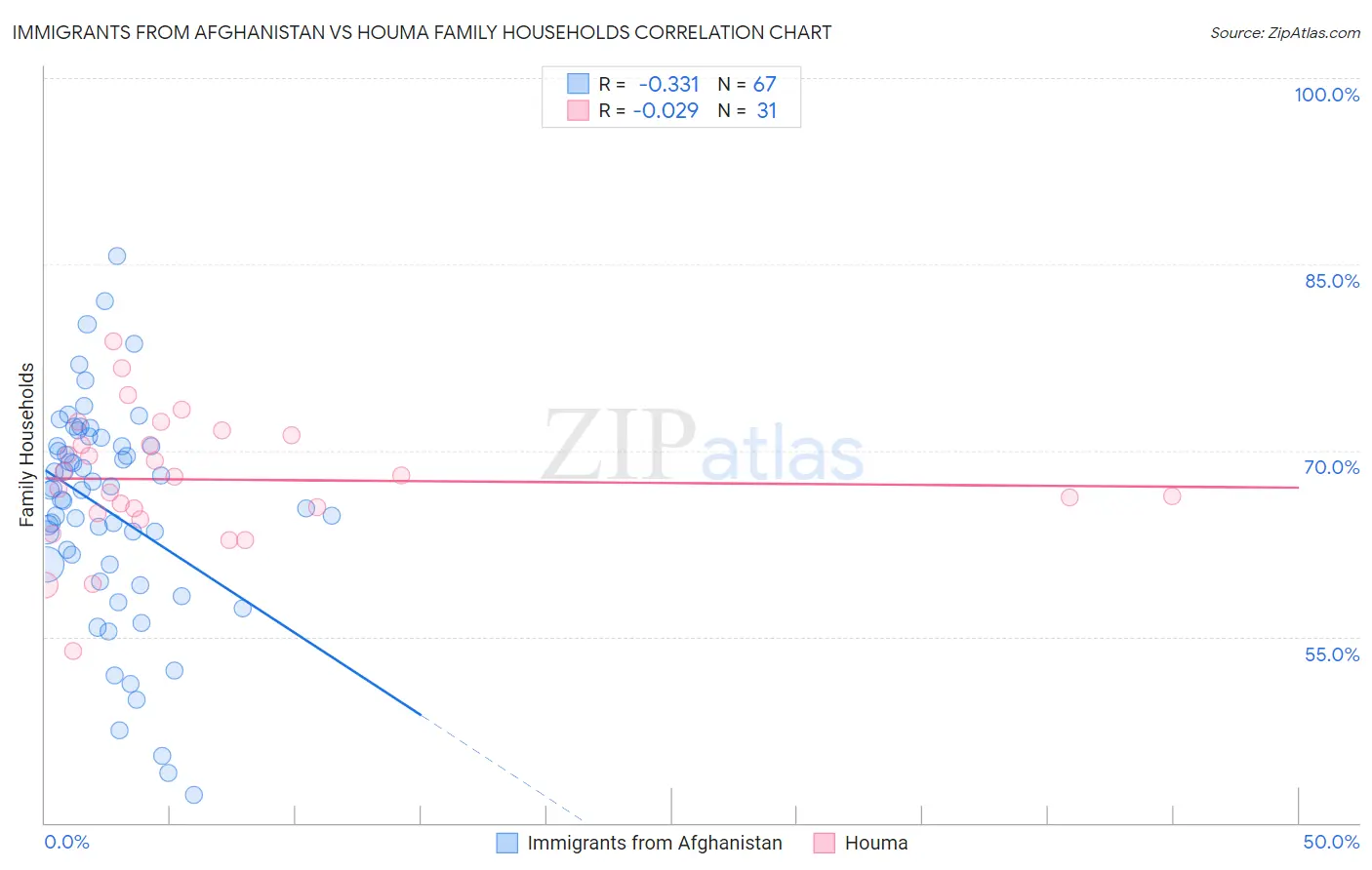Immigrants from Afghanistan vs Houma Family Households
COMPARE
Immigrants from Afghanistan
Houma
Family Households
Family Households Comparison
Immigrants from Afghanistan
Houma
65.9%
FAMILY HOUSEHOLDS
99.9/ 100
METRIC RATING
70th/ 347
METRIC RANK
65.7%
FAMILY HOUSEHOLDS
99.9/ 100
METRIC RATING
75th/ 347
METRIC RANK
Immigrants from Afghanistan vs Houma Family Households Correlation Chart
The statistical analysis conducted on geographies consisting of 147,637,809 people shows a mild negative correlation between the proportion of Immigrants from Afghanistan and percentage of family households in the United States with a correlation coefficient (R) of -0.331 and weighted average of 65.9%. Similarly, the statistical analysis conducted on geographies consisting of 36,793,599 people shows no correlation between the proportion of Houma and percentage of family households in the United States with a correlation coefficient (R) of -0.029 and weighted average of 65.7%, a difference of 0.24%.

Family Households Correlation Summary
| Measurement | Immigrants from Afghanistan | Houma |
| Minimum | 42.3% | 53.8% |
| Maximum | 85.6% | 78.8% |
| Range | 43.4% | 25.0% |
| Mean | 65.1% | 67.7% |
| Median | 66.8% | 67.8% |
| Interquartile 25% (IQ1) | 60.8% | 65.0% |
| Interquartile 75% (IQ3) | 70.4% | 71.2% |
| Interquartile Range (IQR) | 9.6% | 6.3% |
| Standard Deviation (Sample) | 8.8% | 5.2% |
| Standard Deviation (Population) | 8.7% | 5.1% |
Demographics Similar to Immigrants from Afghanistan and Houma by Family Households
In terms of family households, the demographic groups most similar to Immigrants from Afghanistan are Malaysian (65.9%, a difference of 0.010%), Bhutanese (65.9%, a difference of 0.020%), Japanese (65.9%, a difference of 0.040%), Fijian (65.9%, a difference of 0.060%), and Filipino (65.9%, a difference of 0.060%). Similarly, the demographic groups most similar to Houma are Burmese (65.7%, a difference of 0.050%), Laotian (65.8%, a difference of 0.090%), Immigrants from the Azores (65.6%, a difference of 0.12%), Immigrants from South America (65.6%, a difference of 0.12%), and Yaqui (65.6%, a difference of 0.12%).
| Demographics | Rating | Rank | Family Households |
| Central Americans | 100.0 /100 | #62 | Exceptional 66.0% |
| Immigrants | Indonesia | 100.0 /100 | #63 | Exceptional 66.0% |
| Pima | 99.9 /100 | #64 | Exceptional 65.9% |
| Costa Ricans | 99.9 /100 | #65 | Exceptional 65.9% |
| Fijians | 99.9 /100 | #66 | Exceptional 65.9% |
| Filipinos | 99.9 /100 | #67 | Exceptional 65.9% |
| Japanese | 99.9 /100 | #68 | Exceptional 65.9% |
| Malaysians | 99.9 /100 | #69 | Exceptional 65.9% |
| Immigrants | Afghanistan | 99.9 /100 | #70 | Exceptional 65.9% |
| Bhutanese | 99.9 /100 | #71 | Exceptional 65.9% |
| Portuguese | 99.9 /100 | #72 | Exceptional 65.8% |
| Laotians | 99.9 /100 | #73 | Exceptional 65.8% |
| Burmese | 99.9 /100 | #74 | Exceptional 65.7% |
| Houma | 99.9 /100 | #75 | Exceptional 65.7% |
| Immigrants | Azores | 99.8 /100 | #76 | Exceptional 65.6% |
| Immigrants | South America | 99.8 /100 | #77 | Exceptional 65.6% |
| Yaqui | 99.8 /100 | #78 | Exceptional 65.6% |
| Immigrants | Costa Rica | 99.8 /100 | #79 | Exceptional 65.6% |
| Puget Sound Salish | 99.8 /100 | #80 | Exceptional 65.6% |
| Jordanians | 99.7 /100 | #81 | Exceptional 65.5% |
| Immigrants | Lebanon | 99.7 /100 | #82 | Exceptional 65.5% |